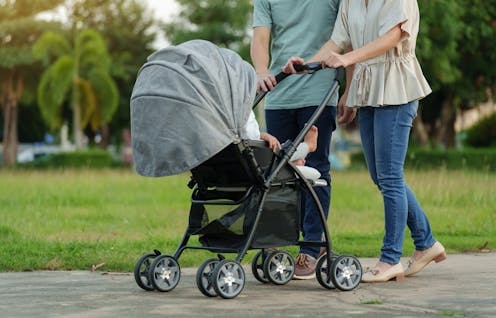
Australia’s fertility rate has fallen to a new record low of 1.5 babies per woman. That’s well below the “replacement rate” of 2.1 needed to sustain a country’s population.
On face value, it might not seem like a big deal. But we can’t afford to ignore this issue. The health of an economy is deeply intertwined with the size and structure of its population.
Australians simply aren’t having as many babies as they used to, raising some serious questions about how we can maintain our country’s workforce, sustain economic growth and fund important services.
So what’s going on with fertility rates here and around the world, and what might it mean for the future of our economy? What can we do about it?
Are lower birth rates always a problem?
Falling fertility rates can actually have some short-term benefits. Having fewer dependent young people in an economy can increase workforce participation, as well as boost savings and wealth.
Smaller populations can also benefit from increased investment per person in education and health.
But the picture gets more complex in the long term, and less rosy. An ageing population can strain pensions, health care and social services. This can hinder economic growth, unless it’s offset by increased productivity.
Other scholars have warned that a falling population could stifle innovation, with fewer young people meaning fewer breakthrough ideas.

A global phenomenon
The trend towards women having fewer children is not unique to Australia. The global fertility rate has dropped over the past couple of decades, from 2.7 babies per woman in 2000 to 2.4 in 2023.
However, the distribution is not evenly spread. In 2021, 29% of the world’s babies were born in sub-Saharan Africa. This is projected to rise to 54% by 2100.
There’s also a regional-urban divide. Childbearing is often delayed in urban areas and late fertility is more common in cities.
In Australia, we see higher fertility rates in inner and outer regional areas than in metro areas. This could be because of more affordable housing and a better work-life balance.
But it raises questions about whether people are moving out of cities to start families, or if something intrinsic about living in the regions promotes higher birth rates.
Fewer workers, more pressure on services
Changes to the makeup of a population can be just as important as changes to its size. With fewer babies being born and increased life expectancy, the proportion of older Australians who have left the workforce will keep rising.
One way of tracking this is with a metric called the old-age dependency ratio – the number of people aged 65 and over per 100 working-age individuals.
In Australia, this ratio is currently about 27%. But according to the latest Intergenerational Report, it’s expected to rise to 38% by 2063.
An ageing population means greater demand for medical services and aged care. As the working-age population shrinks, the tax base that funds these services will also decline.

Unless this is offset by technological advances or policy innovations, it can mean higher taxes, longer working lives, or the government providing fewer public services in general.
What about housing?
It’s tempting to think a falling birth rate might be good news for Australia’s stubborn housing crisis.
The issues are linked – rising real estate prices have made it difficult for many young people to afford homes, with a significant number of people in their 20s still living with their parents.
This can mean delaying starting a family and reducing the number of children they have.
At the same time, if fertility rates stay low, demand for large family homes may decrease, impacting one of Australia’s most significant economic sectors and sources of household wealth.
Read more: No savings? No plans? No Great Australian Dream. How housing is reshaping young people's lives
Can governments turn the tide?
Governments worldwide, including Australia, have long experimented with policies that encourage families to have more children. Examples include paid parental leave, childcare subsidies and financial incentives, such as Australia’s “baby bonus”.
Many of these efforts have had only limited success. One reason is the rising average age at which women have their first child. In many developed countries, including Australia, the average age for first-time mothers has surpassed 30.
As women delay childbirth, they become less likely to have multiple children, further contributing to declining birth rates. Encouraging women to start a family earlier could be one policy lever, but it must be balanced with women’s growing workforce participation and career goals.
Research has previously highlighted the factors influencing fertility decisions, including levels of paternal involvement and workplace flexibility. Countries that offer part-time work or maternity leave without career penalties have seen a stabilisation or slight increases in fertility rates.

The way forward
Historically, one of the ways Australia has countered its low birth rate is through immigration. Bringing in a lot of people – especially skilled people of working age – can help offset the effects of a low fertility rate.
However, relying on immigration alone is not a long-term solution. The global fertility slump means that the pool of young, educated workers from other countries is shrinking, too. This makes it harder for Australia to attract the talent it needs to sustain economic growth.
Australia’s record-low fertility rate presents both challenges and opportunities. On one hand, the shrinking number of young people will place a strain on public services, innovation and the labour market.
On the other hand, advances in technology, particularly in artificial intelligence and robotics, may help ease the challenges of an ageing population.
That’s the optimistic scenario. AI and other tech-driven productivity gains could reduce the need for large workforces. And robotics could assist in aged care, lessening the impact of this demographic shift.
The authors do not work for, consult, own shares in or receive funding from any company or organisation that would benefit from this article, and have disclosed no relevant affiliations beyond their academic appointment.
This article was originally published on The Conversation. Read the original article.







